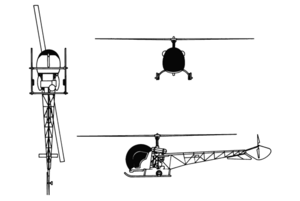PlaneSpottingWorld welcomes all new members! Please gives your ideas at the Terminal.
Bell 207
| Bell 207 Sioux Scout | |
|---|---|
| Bell Model 207 Sioux Scout | |
| Type | Experimental attack helicopter |
| Manufacturer | Bell Helicopter |
| Developed from | Bell 47 |
The Bell 207 Sioux Scout was an early helicopter gunship developed privately for US forces in Vietnam. It featured a tandem cockpit, stub wings for weapons, and a chin-mounted gun turret.
Contents
Design and development
The Bell company had been interested in the concept of a dedicated helicopter gunship since 1958, and unveiled a mockup of such a rotorcraft in June 1962. The "D225 Iroquois Warrior" was based on the engine and mechanics of the Huey, but had a new sharklike fuselage that gave it the looks of a fighter. It had a tandem two-seat cockpit with a gunner in front and a pilot in back, with the seats stepped to give the pilot good forward visibility; a turret with an automatic grenade launcher in the nose; a forward-firing 20 millimeter cannon in a belly pack; and stub wings with stores pylons to carry munitions, such as six SS-11 wire-guided missiles.[1]
The Army liked the idea and awarded Bell a contract in December 1962 to develop a proof-of-concept demonstrator. Bell engineers quickly modified the company's well-established Model 47 / OH-13 Sioux piston-powered helicopter to produce the "Model 207 Sioux Scout", which was completed in August 1963. The Sioux Scout featured a streamlined fuselage, with a tandem cockpit and a chin turret with two 7.62 millimeter M60 machine guns.[1] It only generally resembled the Iroquois Warrior mockup and was too light for actual combat use, but after evaluating the Sioux Scout, the Army was impressed.
Specifications
Bell 207
General characteristics
- Crew: Two in tandem
- Powerplant: One Lycoming TVO-435-F1A Flat-6 piston engine (280 hp/210 kW)
- Armament: One Emerson Electric TAT-101 chin-turret armed with two 7.62mm machine-guns
Bell 47G (for comparison)
Data from International Directory of Civil Aircraft[2]
General characteristics
- Crew: Three
- Length: 31.6 ft (9.63 m)
- Rotor diameter: 37.2 ft (11.32 m)
- Height: 9.28 ft (2.83)
- Disc area: 1,085 ft² (m100.8 m²)
- Empty weight: 1,893 lb (858 kg)
- Max takeoff weight: 2,950 lb (1,340 kg)
- Powerplant: 1× Lycoming TVO-435-F1A Flat-6 piston engine, 280 hp (210 kW)
Performance
- Maximum speed: 91 kt (105 mph, 169 km/h)
- Cruise speed: 73 kt (84 mph, 135 km/h) at 5,000 ft (1,525 m)
- Range: 214 nm (245 miles, 395 km) at 6,000 ft (1,830 m)
- Rate of climb: 860 ft/min (262 m/min)
- Hover ceiling: 17,700 ft IGE; 12,700 ft OGE (5,400 m IGE; 3900 m OGE)
See also
Related development
Comparable aircraft
Related lists
Lists relating to aviation | |
|---|---|
| General | Timeline of aviation · Aircraft · Aircraft manufacturers · Aircraft engines · Aircraft engine manufacturers · Airports · Airlines |
| Military | Air forces · Aircraft weapons · Missiles · Unmanned aerial vehicles (UAVs) · Experimental aircraft |
| Notable incidents and accidents | Military aviation · Airliners · General aviation · Famous aviation-related deaths |
| Records | Flight airspeed record · Flight distance record · Flight altitude record · Flight endurance record · Most produced aircraft |
References
- ↑ 1.0 1.1 Greg Goebel's Vectorsite
- ↑ Frawley, Gerard: The International Directory of Civil Aircraft, 2003-2004, page 420. Aerospace Publications Pty Ltd, 2003. ISBN 1-875671-58-7
The initial version of this article was based on a public domain article from Greg Goebel's Vectorsite.
External links
- Arthur M. Young story and the development of the Model 47 (PDF file with photographs)
- Bell 47 Enthusiast site
- Model 47G specs from The International Directory of Civil Aircraft by Gerard Frawley
Fighter aircraft: YFM-1 · P-39 · P-59 · P-63 · XP-77 · XP-83
Commercial Helicopters: 47 · 204 · 205 · 206 · 210 · 212 · 214 · 222 · 230 · 407 · 412 · 417 · 427 · 429 · 430
Military Helicopters: H-13 · UH-1 · 207 · 209 · AH-1 · 309 · YAH-63 · OH-58 · ARH-70
Tiltrotors: V-22 · BA609 · TR918 · QTR
Experimental aircraft: X-1 · X-2 · X-5 · X-20 X-22 · XV-3 · XV-15 · 533 ·
Lists relating to aviation | |
|---|---|
| General | Timeline of aviation · Aircraft · Aircraft manufacturers · Aircraft engines · Aircraft engine manufacturers · Airports · Airlines |
| Military | Air forces · Aircraft weapons · Missiles · Unmanned aerial vehicles (UAVs) · Experimental aircraft |
| Notable incidents and accidents | Military aviation · Airliners · General aviation · Famous aviation-related deaths |
| Records | Flight airspeed record · Flight distance record · Flight altitude record · Flight endurance record · Most produced aircraft |
| This article is licensed under the GNU Free Documentation License. It uses material from the Wikipedia article "Bell 207". |


